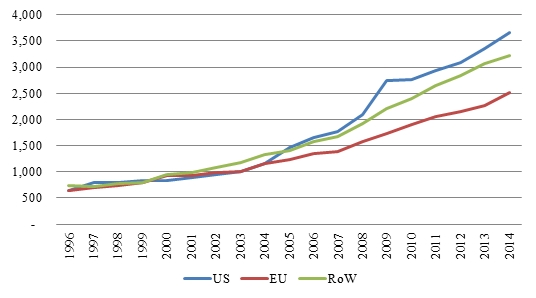By Georgios Alaveras, Estrella Gomez-Herrera and Bertin Martens
This paper explores new data sources on multilateral trade in films among EU countries and with the USA in offline cinema and in online video-on-demand distribution. We observe variations in trade patterns across countries and films and explore how they affect cultural diversity.
The film industry has its own specific characteristics. It has high fixed production costs, benefits from economies of scale and faces significant trade costs related to cultural distance. According to Helpman and Krugman (1985) this type of industries tend to be more competitive when they are located in large home markets and face significant trade costs. This explains why film producers located in the large US market dominate not only their home market, but also account for a large market share in smaller countries. Operating in a large home market enables firms to maximize economies of scale, be more competitive and produce a larger variety of products. That, in turn, will make industries based in larger economies more successful exporters, compared to those that export from smaller economies, and take a more than proportionate share of domestic markets in these smaller economies.
Figure 1 shows how film production has rapidly increased over the period 1996-2014. Cumulative world feature film production reached about 91,000 titles over the period 1996-2014 according to IMDb, the most comprehensive database on films. About 40% of these films were produced in the US and 30% in the EU.
Figure 1. Film production by country and year
Notes: Data from IMDB. We restricted data to feature film productions with duration between 60′ and 140′ minutes, suitable for cinema audiences, in order to exclude short films and video clips, etc. Data on duration was obtained from the ftp server of the Freie Universität de Berlin. RoW stands for “rest of the world”.
Our paper shows that premium demand for US films is driven by box office hits and diminished by competition. The top 50 films from the USA have a much higher EU market share than top 50 domestic EU films in that same market. That, in turn, allows US producers to invest more in the next film production and increase chances of reaching the top 50 again. However, these figures vary substantially across countries. US films can reach up to a third of the total market in smaller countries like Croatia, Greece, Latvia and Luxemburg. The number and variety of films available in these countries is more limited, and consumers converge on the most popular films.
At the other end of the spectrum, larger and more developed film markets like Germany, Belgium, France, Italy and Spain offer a wider variety of titles and the market share of the top 50 is much smaller. That lowers the market share of top-ranking US films as well. They face more competing titles in the market, and consumers spread their film expenditure over a larger number of titles.
It is not all gloom though in the European film industry. Some countries manage to generate considerable export revenue. The UK does very well, making about two-thirds of its revenue in export markets. That figure goes down to about a third for Germany and down to a quarter for France and Spain, with large producer Italy closing the big league ranks at 13% only. The performance of smaller producers is spread out across the entire range, with for instance Belgium, Austria and Slovakia doing well, mainly because they have cultural and linguistic proximity with larger neighbouring country markets.
All in all, the previous facts suggest that geographical market fragmentation poses a challenge for the online and offline EU film industry. We define an availability indicator as the ratio of actual over potential availability of products from all countries of origin in all countries of destination. The data show a wide gap in geographical distribution between US and EU films in the EU market—US films are nearly three times more widely distributed in the EU than EU films. EU films turn out to be very domestic products—nearly 60% is available in one country only, usually the country of origin.
Finally, we compare the observed cross-border trade patterns for films in offline cinema and online Video on Demand (VoD) distribution in the EU. The VoD data in this sample were collected mostly from national VoD platforms and cover very few multi-country or global VoD distribution platforms. Local films therefore dominate the sample composition and result in higher home bias. We find that domestic market shares have a somewhat stronger impact on offline cross-border film trade, compared to online. When we compare the propensity to travel online for US and EU films we observe that cultural distance is a major obstacle for US films to enter the EU VoD market.
Therefore, trade patterns in online film distribution are not fundamentally different. As online distribution occurs downstream from theatrical release, online distributors can benefit from cinema market experience to make a better selection of films. This results in a lower impact of domestic market shares on online trade patterns.
The article is based on:
Alaveras, G., Gomez-Herrera, E. & Martens, B. J Cult Econ (2018) 42: 645. https://doi.org/10.1007/s10824-018-9322-8
About the authors:
Georgios Alaveras, Estrella Gomez-Herrera, Bertin Martens – scientific officers at Joint Research Center, European Commission
Image source:
Jan Wörner, European Space Agency, The pale blue dot – fragile and valuable.


Leave a Reply